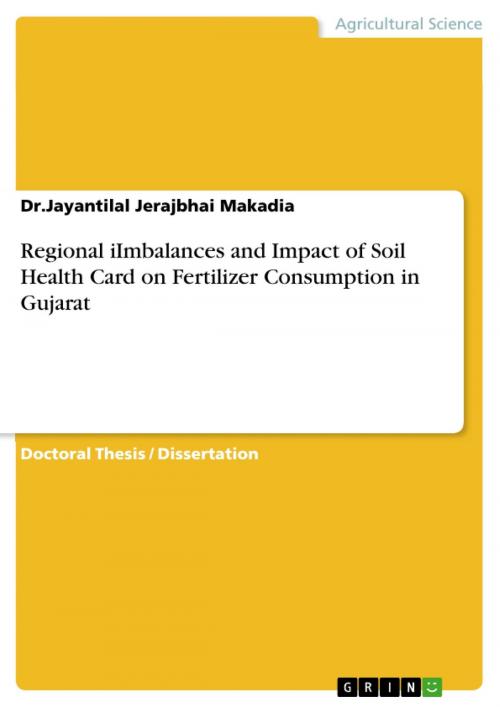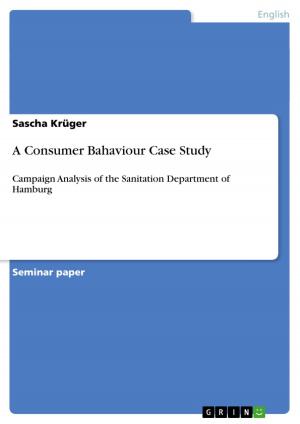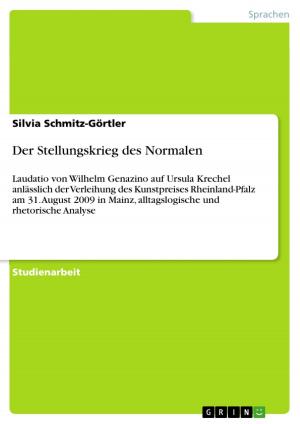Regional iImbalances and Impact of Soil Health Card on Fertilizer Consumption in Gujarat
Nonfiction, Science & Nature, Technology, Agriculture & Animal Husbandry| Author: | Dr.Jayantilal Jerajbhai Makadia | ISBN: | 9783956876028 |
| Publisher: | GRIN Publishing | Publication: | June 19, 2015 |
| Imprint: | GRIN Publishing | Language: | English |
| Author: | Dr.Jayantilal Jerajbhai Makadia |
| ISBN: | 9783956876028 |
| Publisher: | GRIN Publishing |
| Publication: | June 19, 2015 |
| Imprint: | GRIN Publishing |
| Language: | English |
Doctoral Thesis / Dissertation from the year 2012 in the subject Agrarian Studies, grade: A, , course: Agricultural Economics, language: English, abstract: The present study was undertaken with a view to assess the growth in fertilizer consumption and fertilizer use pattern, to examine the gap between actual use and recommended dose of fertilizer, to study the determinants of fertilizer use, to estimate the fertilizer use efficiency and to study the impact of Soil Health Card on consumption of fertilizer in South Gujarat region. Multistage random sampling technique was used for sample selection. Total sample size comprised of 224 farmers with 50-50 per cent from with and without Soil Health Cards. The primary data were collected for the agricultural year 2010 11 by survey method. The results of the study revealed that among all the crops in South Gujarat region, the highest area was allocated to sugarcane crop, followed by kharif paddy and summer paddy. Among the regions, Middle Gujarat stood at top in consumption of N during all periods and Kutchh stood at the bottom. During the Period-I, IV and VI, the consumption of N fertilizer significantly increased in all the regions of Gujarat state. During Period-II and Period-III, the consumption of N increased significantly in all regions except Saurashtra region. Gujarat as a whole, the consumption of N increased significantly during Period-IV. During Period-V, the consumption of N increased significantly in all regions along with Gujarat as a whole and the lowest instability index was found in South Gujarat region. The consumption of P fertilizer significantly increased in all the regions along with Gujarat as a whole during Period-I. During Period-II, the consumption of P increased significantly only in North Gujarat region. The lowest instability index was found in South Gujarat region (29.07%). During Period-III, the consumption of P increased significantly in all regions except, Saurashtra region. During Period-IV, the compound growth rates were found positive but non-significant in all the regions. During Period-V, the consumption of P increased significantly in North Gujarat and Kutchh regions. For whole period, the consumption of P increased significantly in all regions. The lowest instability index was found in South Gujarat region (29.14%). During the Period-I, the consumption of K fertilizer was not reported in any regions of Gujarat State. During Period-II, the consumption of K increased significantly in Saurashtra, North Gujarat, Kutchh and Gujarat as a whole.
Doctoral Thesis / Dissertation from the year 2012 in the subject Agrarian Studies, grade: A, , course: Agricultural Economics, language: English, abstract: The present study was undertaken with a view to assess the growth in fertilizer consumption and fertilizer use pattern, to examine the gap between actual use and recommended dose of fertilizer, to study the determinants of fertilizer use, to estimate the fertilizer use efficiency and to study the impact of Soil Health Card on consumption of fertilizer in South Gujarat region. Multistage random sampling technique was used for sample selection. Total sample size comprised of 224 farmers with 50-50 per cent from with and without Soil Health Cards. The primary data were collected for the agricultural year 2010 11 by survey method. The results of the study revealed that among all the crops in South Gujarat region, the highest area was allocated to sugarcane crop, followed by kharif paddy and summer paddy. Among the regions, Middle Gujarat stood at top in consumption of N during all periods and Kutchh stood at the bottom. During the Period-I, IV and VI, the consumption of N fertilizer significantly increased in all the regions of Gujarat state. During Period-II and Period-III, the consumption of N increased significantly in all regions except Saurashtra region. Gujarat as a whole, the consumption of N increased significantly during Period-IV. During Period-V, the consumption of N increased significantly in all regions along with Gujarat as a whole and the lowest instability index was found in South Gujarat region. The consumption of P fertilizer significantly increased in all the regions along with Gujarat as a whole during Period-I. During Period-II, the consumption of P increased significantly only in North Gujarat region. The lowest instability index was found in South Gujarat region (29.07%). During Period-III, the consumption of P increased significantly in all regions except, Saurashtra region. During Period-IV, the compound growth rates were found positive but non-significant in all the regions. During Period-V, the consumption of P increased significantly in North Gujarat and Kutchh regions. For whole period, the consumption of P increased significantly in all regions. The lowest instability index was found in South Gujarat region (29.14%). During the Period-I, the consumption of K fertilizer was not reported in any regions of Gujarat State. During Period-II, the consumption of K increased significantly in Saurashtra, North Gujarat, Kutchh and Gujarat as a whole.















